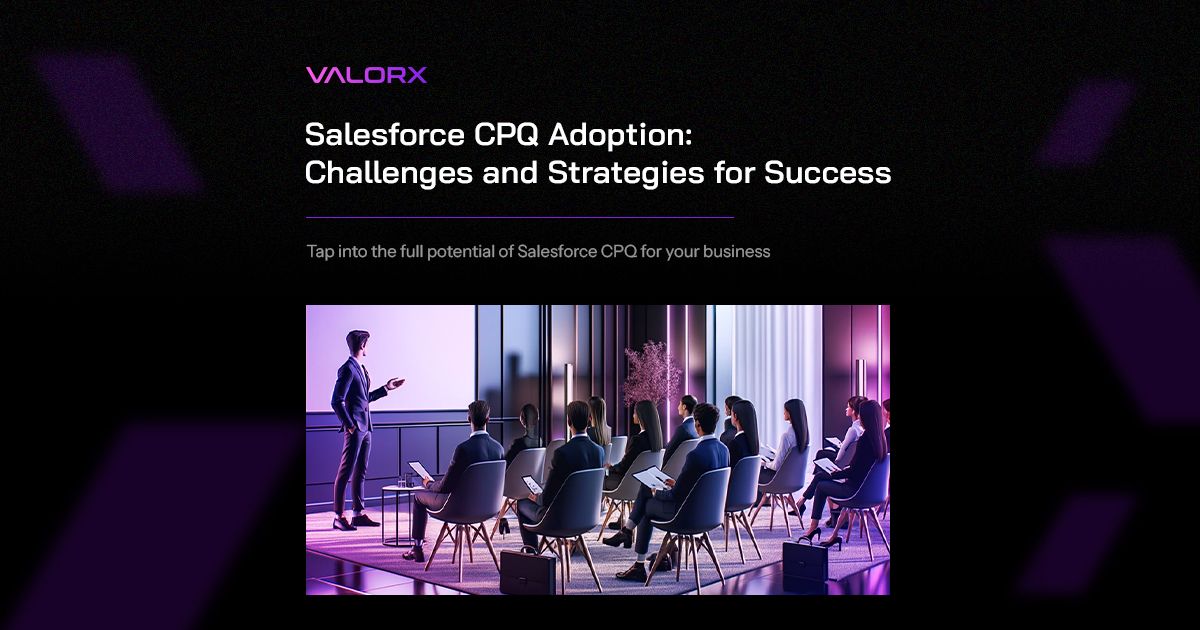Salesforce CPQ (Configure, Price, Quote) is the leading complex quoting software for sales operations. Salesforce CPQ is designed to drive efficiency, accuracy, and faster deal closures by streamlining the quoting process.
However, many businesses struggle with effective adoption of Salesforce CPQ, which ultimately limits the potential for improvements on conversion and incremental revenue generation. From navigating system configuration and customization to the hurdles of integrating with existing technology stacks, harnessing the full potential of Salesforce CPQ comes with a fair share of complexity.
Moreover, user training and proficiency adds to the complexity. How do businesses ensure that their teams onboard and embrace the new tools and workflows? The success of Salesforce CPQ adoption hinges on more than just implementing the software; it requires a strategic approach that supports the needs of all its end users.
Let’s take a look at what makes CPQ adoption difficult for businesses, and how teams can adopt the platform more successfully.
Bumps along the path to Salesforce CPQ adoption
Salesforce CPQ adoption challenges can vary from one business to the other depending on its needs, resources, and structure. But broadly speaking, on the path to adopting Salesforce CPQ, there are common challenges the majority of businesses run into.
Complex Configuration and Customization:
Salesforce CPQ is a powerful tool that can handle complex product configurations and pricing models. This capability itself is rather complex. Tailoring the system to fit specific business needs requires a deep understanding of both the CPQ software and the company's unique sales processes. Organizations often need skilled professionals who are proficient in Salesforce to configure and customize the system effectively. This can lead to a steep learning curve and potentially prolonged implementation times.
Integration with Existing Systems:
Many organizations use a range of software tools for different aspects of their business operations. Integrating Salesforce CPQ with these existing systems (like CRM, ERP, or e-commerce platforms) can be a significant challenge. Ensuring seamless data flow between Salesforce CPQ and other systems is crucial for maintaining data accuracy and process efficiency. This integration also requires technical expertise and can involve complex data migration and synchronization processes.
User Adoption and Training:
A final major challenge is ensuring that all users, from sales representatives to managers, are comfortable and proficient with the new system. Salesforce CPQ changes the way sales teams work, and resistance to change is a common issue. Adequate training and support are essential for successful adoption. Users need to understand not just how to use the system, but also how it improves the sales process and benefits them. Overcoming the initial resistance and ensuring ongoing engagement can require significant time and resources.
Unsustainable Salesforce CPQ workarounds
When Salesforce CPQ adoption is slow going and resistance is high, many sales team members, administrators, and others find different ways to work with the CPQ system - namely, in Excel spreadsheets.
Excel remains a powerful and versatile data management software, refined by decades of development. Its interface is familiar, intuitive, and customizable, making it easy and efficient to work with. This reliance on spreadsheets however leads to poor data hygiene, incomplete data, and the inability to plan effectively using Salesforce data for businesses. It also fails to take complete advantage of Salesforce CPQ’s capabilities.
Many businesses find themselves in this position. They have implemented Salesforce CPQ, but employees are finding it difficult to work productively in the system, opting instead to take their CRM data offline and manage in spreadsheets. Now the business lacks visibility over all the offline quoting work, and the significant Salesforce CPQ implementation fails to streamline quoting or drive increased revenue as expected.
What options remain for businesses that have an underutilized Salesforce CPQ system, inefficient quoting processes, and struggles to drive CPQ adoption?
Driving Salesforce CPQ adoption with the right tools
Many applications are designed to support the various ways Salesforce is used by businesses today. That includes Salesforce CPQ.
Valorx Fusion allows Salesforce CPQ users to integrate Excel spreadsheets directly with Salesforce. Salesforce continues to be the source of truth / master of data, but now users have the ability to leverage Excel as the UX layer that sits over their Salesforce data. This allows every user to edit and update live Salesforce data directly from their Excel spreadsheets without ever taking any data outside of their CRM.
Using Fusion, Salesforce CPQ sales teams can build and collaborate on quotes in spreadsheets. From their spreadsheets they can edit hundreds of records at once, apply and manage multiple dimensions, work with multi-object views, incorporate pivot tables, and so much more. All the while, they work with live Salesforce data, Salesforce permissions and rules are carried over for each user, maintaining consistent data access rules.
Salesforce CPQ administrators can easily manage pricebooks across regions and clients; discounting structures including tier types; approval processes; product configuration rules as products and services evolve; and directly address the needs of sales throughout the quote life cycle - all from their Salesforce-synced spreadsheets.
To learn more about how Valorx Fusion drives successful Salesforce CPQ adoption, check out The Complete Guide to Optimizing Salesforce CPQ.

